Abstract
The reduction of the population and labour force in rural areas, adverse climate changes, soil pollution and degradation, and reduced soil fertility necessitate new and intensive approaches to and methods of vegetable production. In this study, a new high-tech, small-scale hydroponic system based on the Internet of Things (IoT) for growing leafy vegetables was designed. For the assembly of the high-tech small-scale hydroponic system, low-cost materials and sensors are used, allowing remote monitoring and process automation during the cultivation of leafy vegetables and seedlings. Experimental investigations of the installation were conducted, with lettuce as the grown crop. The environmental and technological parameters of the system were monitored and analysed in order to assess the suitability of the system. The obtained results confirm that the small-scale hydroponic system maintained the set parameters of air temperature, air humidity and pH of the nutrient solution within the optimal limits for growing lettuce. Other parameters, such as temperature and electrical conductivity of the nutrient solution, had small deviations from the required optimal limits. In the initially set experiment, 75% germination of the lettuce seeds was achieved. The main advantages of the proposed hydroponic system are the simplicity of its management and easy installation. Furthermore, it offers the possibility for remote monitoring and control without any high requirements towards the experience of the user with such facilities. The designed and implemented small hydroponic system can help small and medium-sized vegetable growers achieve indoor sustainable farming of leafy vegetables year-round.
1. Introduction
Migration from rural to urban locations in many countries, including Bulgaria, led to an increase in the population in large cities and the significant depopulation of rural areas. In the near future, globally, 75% of people are expected to live in cities []. According to data from the National Statistical Institute, in 2021, the population in cities in Bulgaria was 73.3%, and in villages, it was 26.7%. The decrease of the population in the rural areas led to the reduction of the labour force in these areas, which is why the type of agricultural crops grown also changed. Vegetable production, as one of the priority industries for the country, has shifted from cereal grain and oil crops to areas suitable for vegetable production. At the same time, the desire of people from urban areas to consume high-quality and fresh vegetables is a challenge for modern farmers, forcing them to produce more agricultural products with less labour. Another problem facing modern agriculture is climate change, which leads to severe drought, soil degradation due to water and wind erosion, the influence of anthropogenic factors that lead to a decrease in soil fertility, etc. Open-field farming is still the main way of producing agricultural produce in many countries, despite the risks of water scarcity and soil contamination with pesticides and fertilizers []. When it comes to growing vegetables, unfortunately, not all areas are suitable for outdoor production. In those areas where there are insufficient water resources and the arable land is heavily polluted with reduced soil fertility, it is necessary to look for new intensive approaches and production methods. One of these methods is growing vegetables in aqueous solutions or substrates, such as sheep’s wool [,].
Three common types of hydroponic systems have been identified, depending on the way water is supplied to the vegetables’ roots []: nutrient film technique systems, deep-water culture systems and aeroponic systems. The transition to growing vegetables without soil leads to a continuous production cycle, high production yield without the constraints of climate and weather conditions, an increased number of plants per unit area, automation of production processes and a reduction in the need for labour [,,]. Furthermore, Duan et al. [] reported that the number of leaves per plant and the seedling survival rate is higher in hydroponic systems, and according to [], their water consumption is lower compared to conventional farming.
Regardless of the advantages and possibilities of using hydroponic systems, they still remain too expensive for small farmers. A hydroponic floating system is a water-conscious system where a plant is placed in a floating net pot on the surface of water, and the content of inorganic fertilizers contained in the media is the main source of nutrients for the plants. Gumisiriza et al. [] suggested a solution for a simplified low-tech hydroponic system for growing leafy vegetables alongside testing its economic viability. The Kratky hydroponic method, which involves growing crops using water as a media without the need for water pumps and electricity, was used. It is suitable for growing leafy vegetables with intensive growth. In Kratky’s hydroponic method, the plants are placed in plastic mesh pots, the nutrient solution is added first, and the environment around the plants is moistened via capillaries []. The reduction of the nutrient solution is directly proportional to the growth of the plant. As the plant’s root system grows, the air space around the root increases. The crop of leafy vegetables is harvested before the solution is completely used up. The advantage of this method is that it has low maintenance costs and does not have additional costs for air pumps, climate monitoring systems or additional labour []. Its disadvantage, however, is the need to periodically monitor the level of the nutrient solution. This method is suitable for small-scale production when there is no possibility to automate the processes of growing and harvesting vegetable crops. The use and imposition of readymade hydroponic systems for growing vegetables in different countries of the world does not always turn out to be a good solution. Taking into account the specific production conditions in each country, the level of economic development, and the attitude among farmers to implement these production systems as well as the desire among consumers to consume such production, it is necessary to look for specific regional solutions.
With the rapid advancement of digitalization, the automation of the agricultural processes relies on remote access to the physical objects, using sensors, actuators and software [], which is commonly referred to as the Internet of Things (IoT). This opens up the opportunity for the application of cloud services, data analysis, machine learning, etc., which are the basis for the implementation of precision agriculture []. The role of these IoT devices is to connect the sensors with the controller system and cloud databases over different communication means, thereby providing the system with the necessary data for controlling the processes []. When it comes to hydroponic systems, the application of different sensors and digital cameras allows one to fully monitor and control the process during vegetation [,], thereby allowing the operator to refine and optimize the processes of nutrition, temperature and light regimes, ventilation, etc. []. Khaoula et al. [] presented an interesting solution for an IoT-based aquaponic system, which monitors and optimizes the environment of fish and plants. Several different sensors were used to monitor pH, sunlight, water level, water temperature, electroconductivity, soil moisture, total dissolved solids, air CO2, air temperature, air humidity and ammonia and nitrate levels. Furthermore, the system used several actuators to control the environment, including relays and water pumps.
Hostalrich et al. [] presented the design and development of an IoT-based hydroponic system aimed at providing intelligent management. The following parameters were controlled: ambient temperature and humidity, soil moisture, CO2 and water level. Furthermore, several systems were used for the controlling the process, such as an illumination system, a refrigeration system, a ventilation system and a water pumping system. A similar approach was presented in [], where the IoT-based system relied on a number of sensors (water level and temperature, light, nutrient, air temperature and humidity) and actuators (relays and pumps) to control an aeroponic system. All data was stored in a cloud database for further analysis.
In another study, an IoT-based monitoring system for an aeroponic greenhouse was presented []. It uses a wide variety of sensors for measuring the air temperature and humidity in the greenhouse and in the plant leaf, vapour pressure deficit (VPD), luminosity, level, temperature, and the pH and EC of the water as well as a thermographic camera. Similarly, Dutta et al. [] presented a smart hydroponic system for evaluation of the growth response of lettuce. It uses temperature, humidity, pH, oxygen and CO2 sensors whose readings are stored in a cloud database. The actuators consist of a fan, cooler, water pump, nutrient pump, mist spray, LED and buzzer. The system allows remote monitoring through a remote mobile application. A more simplified solution was presented in [], where a low-cost aquaponic system was described. It relies on sensors for temperature, electric conductivity, pH and water level as well as spectroscopic sensors. The controller can manipulate LED lights and a pump via relays.
The collection of different sensors data in a database opens a number of opportunities for improving the controlled process with the help of artificial intelligence. Dhal et al. [] presented a deep-water culture system in which different machine learning algorithms were compared. They were aimed at regulating the nutrient concentration based on the plants’ needs. For the analysis, a total of 143 observations were used with 21 predictors of the chemicals, pH, EC, hardness, alkalinity, etc. Another study presented a concept for enhancing aquaponic management with the use of IoT-based predictive analytics. A rules-based approach was used to support the decision-making process []. Chang et al. [] also presented the application of a digital camera and artificial intelligence for predicting growth as well as the harvest day and quality of lettuce in a greenhouse.
The performed analysis shows that the application of IoT-based solutions opens a wide range of opportunities for improving the traceability and management efficiency of hydroponic systems. Furthermore, with the help of machine learning, it is possible to provide automatic detection of certain situations, predict growth, optimize nutrition concentration, etc.
The goal of our research was to design a high-tech, small-scale hydroponic system with a seedling productivity of 1350 plants and up to 150 transplanted plants based on the IoT for growing leafy vegetables. It should allow remote monitoring and control of the major characteristics of the leafy vegetables’ cultivation process while still ensuring simplicity of application and management by farmers with average technical and internet skills and knowledge.
2. Materials and Methods
2.1. Architecture of the Hydroponic System
The architecture of the hydroponic system is summarized in Figure 1. It consists of several subsystems:
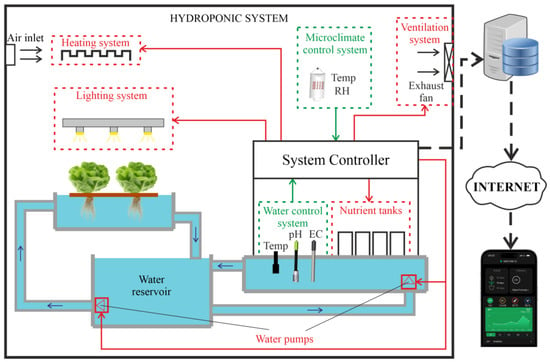
Figure 1.
Functional diagram of system communication.
- -
- Microclimate control system—responsible for monitoring several parameters of the environment, including air temperature and relative humidity. The readings of these sensors are also used to estimate the vapor pressure deficit of the air;
- -
- Water control system—responsible for monitoring some parameters of the nutrient solution, including water temperature, pH and electric conductivity (EC). Furthermore, the system monitors the water level within the reservoir;
- -
- Lighting system—responsible for providing the necessary lighting regime;
- -
- Heating system—responsible for ensuring appropriate environmental temperature conditions within the hydroponic chamber;
- -
- Ventilation system—responsible for ensuring appropriate air exchange and mixture within the hydroponic chamber. It is implemented with an exhaust fan and appropriate air inlet, which blocks insects and light;
- -
- Water pumps—responsible for providing the necessary water debit within the hydroponic system. One of them provides the water flow through the grown vegetables’ roots, and the other one creates the flow through the system controller’s measuring/actuator chamber;
- -
- Nutrient tanks—responsible for maintaining the required fertilizer parameters and pH levels within the water. Additional pumps for each tank could be used, if necessary;
- -
- System controller—responsible for controlling all mentioned systems and maintaining the required environmental and hydroponic conditions within the system.
The controller is connected to a server via a cable or wireless connection. It stores all sensor data and actuator operation characteristics in a database. This allows all data to be accessible and monitored on remote devices (computers, laptops, mobiles, etc.) via the internet.
2.2. Hardware Implementation of the Hydroponic System
A multifunctional, small-scale hydroponic system was implemented in practice. The general scheme of the prototype is summarized in Figure 2. The mechanical construction was implemented with metal racks consisting of tray holding rails with a length of 1400 mm and located on three levels. On each rack, there were 3 growing trays, each with a length of 600 mm and a width of 400 mm. The distance between the individual levels was 435 mm. There were 3 full-spectrum LED growing lights on each level. The full-spectrum LED growing lights were located above the trays at a distance of 328 mm. The dimensions of the designed system are 1400 mm length, 700 mm width and 2000 mm width. Located in the lower part of the system was a nutrient solution tank with a volume of 150 L. With the help of a water pump, the nutrient solution was fed through the irrigation system to the growing trays.
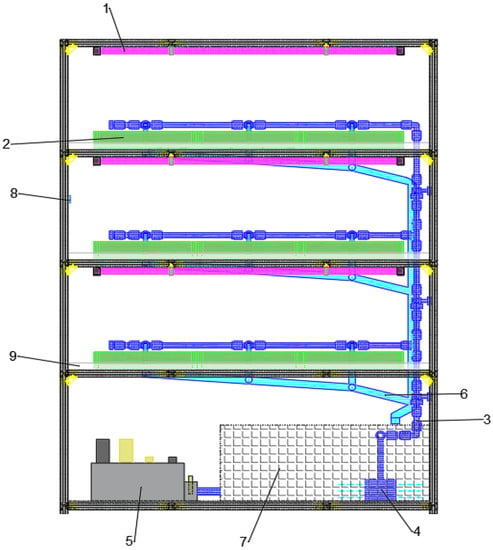
Figure 2.
Scheme of the designed small-scale hydroponic system: (1) Full-spectrum LED growing lights for vertical farming; (2) Growing trays; (3) Irrigation system; (4) Water pump; (5) Automated hydroponic control unit; (6) Drainage system; (7) Nutrient solution tank; (8) Temperature and humidity sensor; (9) Tray holding rails.
The stepwise process of constructing and assembling the system involved:
- (1)
- Assembly of the metal structure of the system;
- (2)
- Installation of the lighting;
- (3)
- Assembly of the rails;
- (4)
- Installation of the irrigation system;
- (5)
- Installation of the drainage system;
- (6)
- Mounting the growing trays;
- (7)
- Mounting the tank with the pump;
- (8)
- Installation of the NIDO ONE Hydroponics Automatic Control Unit;
- (9)
- Installation of temperature and humidity sensors.
Due to the small size of the growing system, it is necessary to use a Grow tent storage structure. For this purpose, a Grow tent model “Dark Room DR150” (Secret Jardin—Agomoon SRL, Manage, Belgium) with dimensions 150 × 150 × 235 cm was chosen. To ensure optimal air circulation and air extraction from the closed area, additional equipment from Secret Jardin was selected: 2 circulation fans, model “Monkey Fan 20 W“ (Secret Jardin—Agomoon SRL, Manage, Belgium), and an extractor fan, model “DF16 Extractor T 150/250/350 m3·h−1” (Secret Jardin—Agomoon SRL, Manage, Belgium), with a “DF16 Carbon Filter 350 m3·h−1” model filter (Secret Jardin—Agomoon SRL, Manage, Belgium). Additionally in this construction, an additional inlet was made for the entry of fresh air from the outside, and a barrier of model “Light Baffle with Mesh DF16LB“ (Secret Jardin—Agomoon SRL, Manage, Belgium) was used, whose function is to block light and provide passive air intake. Micro-mesh filters and insect filters are included with this baffle.
In the heating room, a mini electronic converter model “LivEco Cloud” AirSafe function (Tesy LTD, Shumen, Bulgaria), was installed. It can be controlled over Wi-Fi and is suitable for heating rooms with areas of 4–6 m2 and volumes of 10–15 m3. Furthermore, an air purifier brand Tesy, model AC 16 EHCI (Tesy LTD, Shumen, Bulgaria) with 6 degrees of heat was installed, and it uses the following filters:
- (1)
- Carbon filter—absorbs odours from cooking and pets as well as tobacco smoke. It also picks up larger particles of dust, lint and fur.
- (2)
- NERA filter—absorbs particles, including dust, pollen, fungal spores and various types of bacteria. It cannot absorb particles smaller than 0.3 microns, such as chemical fumes, gases, etc.
- (3)
- VOC filter—absorbs odours and gases.
- (4)
- TiO2 photocatalytic filter—reduces organic pollutants such as benzene and ammonia. It is also responsible for deactivating bacteria and viruses that pass through previous filters and are not absorbed due to their size.
- (5)
- UV filter—effectively destroys the cells of microorganisms, including microbes, viruses, bacteria and fungi, which are not absorbed by previous filters due to their size.
- (6)
- Ionizer—disperses negative ions in the room to improve the cleaning process and, at the same time, freshen the air.
The automation of the process is based on the NIDO ONE hydroponic controller system (Nido S.R.L. Carpineti, Italy). It uses sensors to monitor different indicators, such as relative air humidity, air temperature, amount of nutrient solution and pH of the nutrient solution []. NIDO ONE is a control unit for automatic regulation of the nutrient solution within hydroponic systems and the climatic parameters of indoor cultivation rooms. The lighting operation is controlled via the NIDO Control Unit via the NIDO Plug. It utilizes chainable LED lights (Model L 28 (Valoya Oy, Helsinki, Finland) with a power of 28 watts and spectra AP67, AP673L, G2 and NS12. Cloud and IoT technologies were used for remotely monitoring plants and managing individual measurement indicators.
The following nutrient solutions sensors were used:
- -
- A pH sensor for monitoring acidity with the following parameters: reading scale from 4 to 10, 0.01 pH resolution and 0.1 pH accuracy;
- -
- An EC monitoring sensor with the following parameters: reading scale from 0 to 5.0 mS, 0.01 mS resolution and 0.1 mS accuracy. Furthermore, it has an integrated temperature sensor for EC/TDS temperature compensation;
- -
- A solution level sensor.
Furthermore, the following air parameters sensors were used:
- -
- Air temperature sensor with the following parameters: reading scale from 0 to 50 °C, 0.1 °C resolution and 0.2 °C accuracy (Texas Instruments, Dallas, TX, USA);
- -
- Relative humidity sensor with reading scale from 10 to 100%, 1% resolution and 2% accuracy (Texas Instruments, Dallas, TX, USA).
The frequency of supplying the nutrient solution, the light and temperature regime can be adjusted depending on the biological requirements of the grown vegetables. The inexpensive Nutrient Film Technology (NFT) was used, allowing water to flow on the bottom of the trays in a layer 3 mm deep. A BOYU FP-3000 adjustable pump (Guangdong Boyu Group Co., Ltd., Huanggang Town, China) with a capacity of 3000 L·h−1 was used to supply nutrient solution from the tank to the trays.
The plants were placed in special nests located in trays with nutrient solution. Nine grow trays are available that can be added to almost any hydroponic growing method with simple modifications. In all 9 trays, there were between 50 and 150 plants, depending on the type of crops grown. The system can be modified by the user depending on the scale of production and the technology of growing vegetable crops. The problem of insufficient air exchange in the root system was solved with a cyclic supply of nutrient solution. For trouble-free operation of the pump, regular cleaning of lime scale and mineral deposits was carried out.
The NIDO ONE control unit used in the designed hydroponic system allows automatic regulation and dosing with 4 different nutrient solutions, which makes the implemented system multifunctional with the possibility of growing more than one type of vegetable with similar vegetative requirements. The control unit is compatible with tanks from 10 to 2500 L, which provides possibilities for modification and increasing the scale of production. The automatic control unit monitors pH and EC values and adds nutrition, additives or pH regulators according to the user’s settings.
The communication between the hydroponic system controller and the server was implemented over a Wi-Fi network via a gateway, which does not require a permanent online connection for normal operation. The remote access to the system was implemented using the NIDO smartphone app or with a web-based interface. The application can be used to create different programs for growing crops according to the farmer’s preferences. The software tool also allows one to observe the data from the database, which represents the monitored indicators within the hydroponic system.
2.3. Organization of the Experimental Investigations
To establish the functional suitability of the designed system, experimental studies with leafy vegetables were conducted. Leafy vegetables suitable for hydroponic cultivation are lettuce, arugula, kale, mustard and spinach. Due to the short growing season, for the purpose of the experiment, a lettuce (Lactuca sativa) May King variety was planted (Figure 3). May King is an early and hardy lettuce variety that is pale green with a pink tinge to its inner leaves, and it is suitable for hydroponic cultivation. The developed system works with ready-made nutrient solutions depending on the type of culture grown:

Figure 3.
Photo of the constructed small-scale hydroponic system in the first day of growing.
- -
- Fertilizer A + fertilizer B + fertilizer C and pH− solution;
- -
- Fertilizer A + fertilizer B + fertilizer C and pH+ solution;
- -
- Fertilizer A + fertilizer B and solutions for pH+ and pH−.
For the purposes of the experiment, fertilizer from the company Advanced Hydroponics of Holland was used with the following composition: N: 2.5%; P: 1.2%; K: 5.0%. During the first 2 weeks of seed germination, 1 mL of the fertilizer was diluted in 1 L of water. From the 3rd to the 4th weeks of vegetation, 2 mL of the fertilizer was diluted in 1 L of water. For the 5th and 6th week of vegetation, 1 mL of the fertilizer was diluted in 1 L of water. To regulate acidity and lower the pH, the product BioNova PH-500 mL, which contains 24.5% phosphoric acid, was used. The dilution was made by adding 4 mL of BioNova to 10 L of solution. The filling of tanks A, B, C and pH was done manually, and 500 mL of solution was poured into each tank. The dosing of the individual solutions was carried out via the NIDO PRO application, after which a salad-growing program was selected. With pH regulators, the concentration of the solution must not exceed 20% phosphoric acid. For lettuce, pH should be maintained within the range of 6–7, and EC should be within 1.2–1.8 mS cm−1.
During the experiment, the hydroponic system ensured 18 h of light per 24 h from the lighting system, and no pesticides were used on the growing lettuce.
3. Results and Discussion
After the initial testing of the lighting system, hoods, heaters, air conditioners and nutrient solution pump, the cubes with the sown seeds were placed in the constructed small-scale hydroponic system (Figure 3). With the help of the NIDO ONE controller, the following data was continuously monitored: the water temperature and EC; the air temperature and humidity; the level, consumption and pH of the nutrient solution; the electrical energy consumption.
A screenshot of the graphical user interface for monitoring and control of the small-scale hydroponic system is presented in Figure 4.
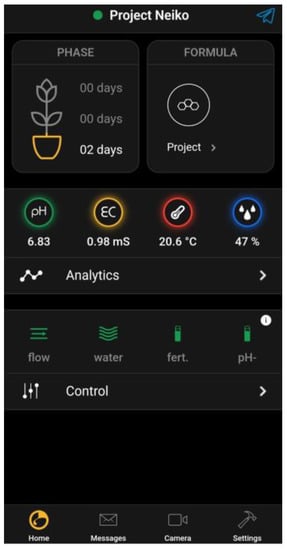
Figure 4.
Graphical user interface for monitoring and control of the constructed small-scale hydroponic system.
In Figure 5, Figure 6, Figure 7, Figure 8 and Figure 9, the time series of the individual measured indicators are visualized as obtained from the NIDOPRO software product. The presented results are for the 3rd and 4th days after the lettuce seeds were sowed.
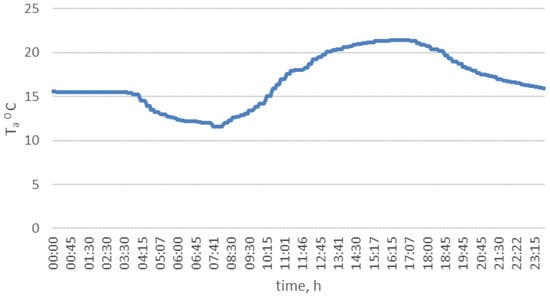
Figure 5.
Time series of ambient temperature.
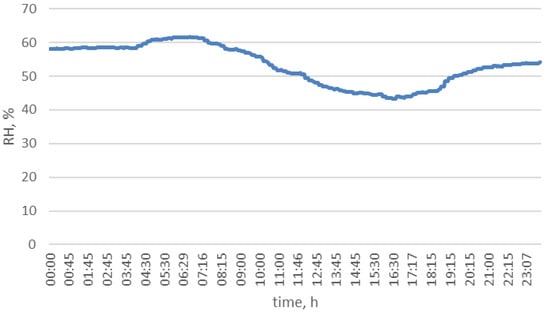
Figure 6.
Time series of relative humidity.
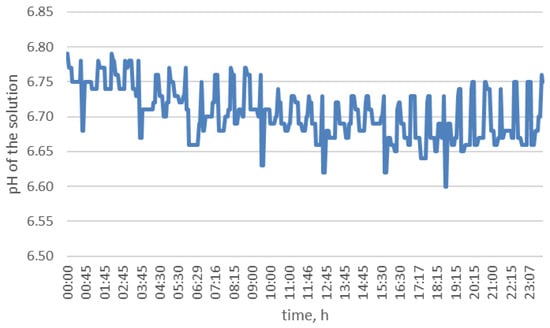
Figure 7.
Time series of the pH of the solution.
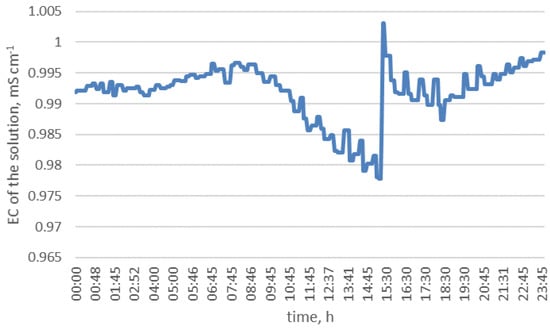
Figure 8.
Time series of the electrical conductivity of the solution.
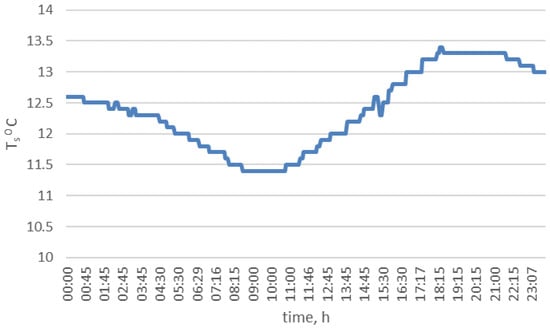
Figure 9.
Time series of the temperature of the solution.
Figure 5 presents the variation of the environment temperature. It can be seen that from 4:00 a.m. to 9:00 a.m., the temperature continuously dropped until it reached 11.5 °C, which was caused by the heating installation turning off periodically to save energy during the night. From 9:00 a.m. to 5:00 p.m., the temperature rose until it reached 21.5 °C. At night, in the hours between 10:00 p.m. and 4:00 a.m., the air temperature was 15.5 °C. From the observations made, it was established that the designed system for maintaining the air temperature worked sustainably and provided the necessary temperature for the germination of the lettuce seeds and the normal vegetative development of the plants. As [] previously reported, the air temperature is an important factor that strongly influences the growth of the lettuce and the quality of the harvested produce.
The time series of the relative humidity is presented in Figure 6. It varied during the different hours of the day, where the highest values from 59% to 62% were recorded between 4:16 a.m. and 8:00 a.m. The lowest relative humidity values, ranging from 46% to 44%, were observed between 1:45 p.m. and 6:00 p.m., which was expected because during this period, the temperature was the highest. During the night hours between 9:30 p.m. and 4:00 a.m., the relative humidity was maintained between 53% and 58%. The relative humidity of the ambient air is an important factor for normal photosynthesis and plant growth. Maintaining high humidity in the hydroponic system reduces the transpiration coefficient in the cultivated lettuce and improves plant growth []. On the other hand, the increase in humidity increases the risk of the development of disease-causing pathogens. In the designed small-scale hydroponic system, there are no humidifiers and absorbers, and therefore, the humidity depends mostly on the environment. In order to improve the functional suitability and universality of the designed hydroponic system, humidifiers and absorbers should be installed, which is planned for the future.
Unlike temperature and humidity, the change in pH of the solution had small amplitude fluctuations and ranged between pH 6.2 and pH 6.78 throughout the day (Figure 7). According to [], the recommended pH of the nutrient solution when growing lettuce is within the interval of 6–7. The obtained results allow us to conclude that the control system was able to maintain the pH of the nutrient solution within the acceptable limits, and therefore, it operated according to expectations.
The electrical conductivity of the nutrient solution is of great importance for plant development. It is an indicator of the total concentration of ions in a solution. In Figure 8, it can be seen that the EC varied between 0.982 mS cm−1 and 1.003 mS cm−1. For the cultivation of lettuce, the EC should be in the range of 1.2–1.8 mS cm−1 []. In the first day of the growing cycle, when the system was started, the EC was 0.637 mS cm−1, and on the 5th day of operation of the hydroponic system, it increased to 1.012 mS cm−1. As can be seen during the reporting period, the system did not maintain the EC within the required limits; moreover, it slowly increased. With an increase in the period of operation, the system is expected to provide EC within the necessary limits. At 3:17 p.m., there was a sudden increase in the EC of the solution. It was caused by the control system, which added additional solution in order to increase the concentration of ions.
During the observation period, we found that the temperature of the nutrient solution fluctuated between 11.4 °C and 13.3 °C (Figure 9). The minimum values were recorded between 8:48 a.m. and 10:45 a.m., and maximum values were recorded between 18:31 p.m. and 10:45 p.m. The temperature of the nutrient solution is a decisive factor for the development and growth of lettuce. According to [,], at water temperatures lower and higher than optimal for plant growth, plant development can be negatively affected. From the observations made, at the reported solution temperature, the lettuce seeds began to germinate on day 4 after sowing, with mass germination of the seeds observed in day 8 (Figure 10).
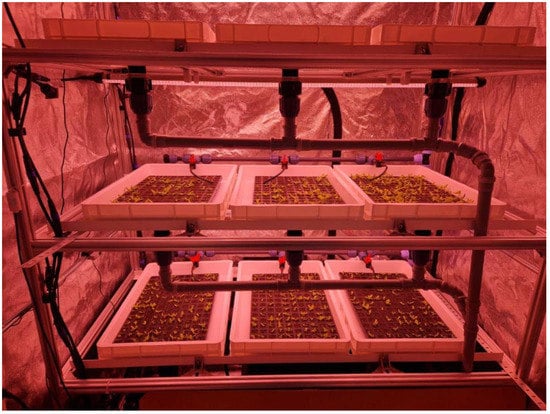
Figure 10.
Germination of lettuce seeds on day 8 after sowing.
From direct observations, it was determined the germination rate of the seeds was 75%. To accelerate seed germination and to achieve universality for growing crops with different vegetation requirements, it is important to make sure a higher solution temperature is maintained. For this purpose, a heater will be added to the constructed small-scale hydroponic system tank, which will be used during the winter season. The obtained germination percent generally corresponds to that obtained in other studies when no additional techniques are used. For example, Sronsri et al. [] reported 76% germination for their referenced lettuce samples and 94% if a magnetic device proposed by them is used. Mot et al. [] reported germination percentages for Lactuca Sativa L. ranging from 83% to 99%, depending on the heavy metal content in the solution, where the lowest germination was for the reference samples without any metal additions.
4. Conclusions
The current study presents the design and development of an IoT-based, small-scale hydroponic system used for growing leafy vegetables and which allows remote monitoring and remote management of the technological process.
It is established that the small-scale hydroponic system maintains the set parameters of air temperature, air humidity and pH of the nutrient solution within the optimal limits for growing lettuce. The system does not maintain high temperature values of the nutrient solution, which indicates that it currently does not allow the use of vegetables with high water temperature requirements. Considering the made observations, a heater should be added to warm the nutrient solution in the tank, thereby improving the flexibility of the system. The first experiment with the system allowed achievement of 75% germination of the lettuce seeds, which is similar to what other studies have reported when no additional techniques are used.
The designed small hydroponic system could be helpful for small and medium-sized vegetable growers that want to achieve year-round yield sustainability in growing leafy vegetables. The suggested system is easy to implement and provides intelligent remote management of the plant growing process. It is characterized by mobility, small size, quick and easy installation, and that it does not require personnel with professional experience to operate or specialized service support and is easy to clean.
Our next step is to design a high-performance hydroponic system that can control a total area of 60 m2. It will be followed by a series of experiments with different vegetable crops in order to ensure the efficiency of the automated growing process. Furthermore, a cost–benefit analysis of such a system should be performed in order to evaluate its profitability for the indoor growing of vegetables under the climate conditions of Bulgaria.
Author Contributions
Conceptualization, A.Z.A. and N.V.N.; methodology, A.Z.A. and B.I.E.; software, N.V.N.; validation, A.Z.A., B.I.E. and V.N.V.; formal analysis, A.Z.A.; investigation, N.V.N.; resources, N.V.N.; data curation, B.I.E.; writing—original draft preparation, A.Z.A. and B.I.E.; writing—review and editing, B.I.E., V.N.V. and S.-S.B.; visualization, N.V.N.; supervision, V.N.V. and S.-S.B. All authors have read and agreed to the published version of the manuscript.
Funding
The APC was funded by the University Politehnica of Bucharest, Romania.
Institutional Review Board Statement
Not applicable.
Data Availability Statement
The data presented in this study are available on request from the corresponding author.
Acknowledgments
The authors would like to give special thanks to the anonymous reviewers, whose valuable comments and suggestions significantly improved the quality of the paper.
Conflicts of Interest
The authors declare no conflict of interest.
References
- United Nations. Goal 11: Make Cities Inclusive, Safe, Resilient and Sustainable. 2018. Available online: https://www.un.org/sustainabledevelopment/cities/ (accessed on 14 April 2023).
- Zárate, M.A. Manual de Hidroponia; Universidad Nacional Autónoma de México: Mexico City, Mexico, 2014. [Google Scholar]
- Hegyi, A.; Bulacu, C.; Szilagyi, H.; Lazarescu, A.-V.; Meita, V.; Vizureanu, P.; Mihaela Sandu, M. Improving Indoor Air Quality by Using Sheep Wool Thermal Insulation. Materials 2021, 14, 2443. [Google Scholar] [CrossRef]
- Komorowska, M.; Niemiec, M.; Sikora, J.; Gródek-Szostak, Z.; Gurgulu, H.; Chowaniak, M.; Atilgan, A.; Neuberger, P. Evaluation of Sheep Wool as a Substrate for Hydroponic Cucumber Cultivation. Agriculture 2023, 13, 554. [Google Scholar] [CrossRef]
- Niu, G.; Masabni, J. Chapter 9—Hydroponics. In Plant Factory Basics, Applications and Advances; Elsevier: Amsterdam, The Netherlands, 2022; pp. 153–166. [Google Scholar] [CrossRef]
- van Delden, S.H.; SharathKumar, M.; Butturini, M.; Graamans, L.J.A.; Heuvelink, E.; Kacira, M.; Kaiser, E.; Klamer, R.S.; Klerkx, L.; Kootstra, G.; et al. Current status and future challenges in implementing and upscaling vertical farming systems. Nat. Food 2021, 2, 944–956. [Google Scholar] [CrossRef] [PubMed]
- Cardoso, F.B.; Martinez, H.E.P.; da Silva, D.J.H.; Milagres, C.C.; Barbosa, J.G. Yield and quality of tomato grown in a hydroponic system, with different planting densities and number of bunches per plant. Pesqui. Agropecuária Trop. 2018, 48, 340–349. [Google Scholar] [CrossRef]
- Mahjoor, F.; Ghaemi, A.A.; Golabi, M.H. Interaction effects of water salinity and hydroponic growth medium on eggplant yield, water-use efficiency, and evapotranspiration. Int. Soil Water Conserv. Res. 2016, 4, 99–107. [Google Scholar] [CrossRef]
- Duan, J.-X.; Duan, Q.-X.; Zhang, S.-F.; Cao, Y.-M.; Yang, C.-D.; Cai, X.-D. Morphological, Physiological, Anatomical and Histochemical Responses of Micropropagated Plants of Trichosanthes Kirilowii to Hydroponic and Soil Conditions during Acclimatization. Plant Cell Tissue Organ Cult. 2020, 142, 177–186. [Google Scholar] [CrossRef]
- Martin, M.; Molin, E. Environmental Assessment of an Urban Vertical Hydroponic Farming System in Sweden. Sustainability 2019, 11, 4124. [Google Scholar] [CrossRef]
- Gumisiriza, M.S.; Ndakidemi, P.A.; Mbega, E.R. A simplified non-greenhouse hydroponic system for small-scale soilless urban vegetable farming. MethodsX 2022, 9, 101882. [Google Scholar] [CrossRef]
- Kratky, B.A. Growing lettuce in three non-aerated, non-circulated hydroponic systems. J. Veg. Crop Prod. 2005, 11, 35–41. [Google Scholar] [CrossRef]
- Kratky, B.A. Three non-circulating hydroponic methods for growing lettuce. Acta Hortic. 2009, 843, 65–72. [Google Scholar] [CrossRef]
- Valov, N.; Valova, I. Drying process management laboratory with remote access. In Proceedings of the 2017 16th International Conference on Information Technology Based Higher Education and Training (ITHET), Ohrid, Macedonia, 10–12 July 2017. [Google Scholar] [CrossRef]
- Kasturi, S.B.; Ellaji, C.H.; Ganesh, D.; Somasundaram, K.; Sreedhar, B. IoT and Machine Learning Approaches for Classifi-cation in Smart Farming. J. Surv. Fish. Sci. 2023, 10, 3373–3385. [Google Scholar]
- Valov, N.; Valova, I. Home automation system with Raspberry Pi. In Proceedings of the 2020 7th International Conference on Energy Efficiency and Agricultural Engineering (EE&AE), Ruse, Bulgaria, 12–14 November 2020. [Google Scholar] [CrossRef]
- Pivoto, D.; Waquil, P.; Talamini, E.; Spanhol, C.; Corte, V.; Mores, G. Scientific development of smart farming technologies and their application in Brazil. Inf. Process. Agric. 2018, 5, 21–32. [Google Scholar] [CrossRef]
- Hostalrich, D.; Pelegri-Sebastia, J.; Sogorb, T.; Pellicer, V. Intelligent Management of Hydroponic Systems Based on IoT for Agrifood Processes. J. Sens. 2022, 2022, 9247965. [Google Scholar] [CrossRef]
- Stefanos, A.; Nikolidakis, D.K.; Dimitrios, D.; Douligeris, C. Energy efficient automated control of irrigation in agriculture by using wireless sensor networks. Comput. Electron. Agric. 2015, 113, 154–163. [Google Scholar] [CrossRef]
- Khaoula, T.; Abdelouahid, R.A.; Ezzahoui, I.; Marzak, A. Architecture design of monitoring and controlling of IoT-based aquaponics system powered by solar energy. Procedia Comput. Sci. 2021, 191, 493–498. [Google Scholar] [CrossRef]
- Jain, S.; Alam, M.; Bokhari, M. Future Hydroponic Systems using IOT for sustainable agriculture. In Proceedings of the 2nd International Conference on ICT for Digital, Smart, and Sustainable Development, Jamia Hamdard, New Delhi, India, 27–28 February 2020. [Google Scholar] [CrossRef]
- Méndez-Guzmán, H.A.; Padilla-Medina, J.A.; Martínez-Nolasco, C.; Martinez-Nolasco, J.J.; Barranco-Gutiérrez, A.I.; Contreras-Medina, L.M.; Leon-Rodriguez, M. IoT-Based Monitoring System Applied to Aeroponics Greenhouse. Sensors 2022, 22, 5646. [Google Scholar] [CrossRef]
- Dutta, M.; Gupta, D.; Sahu, S.; Limkar, S.; Singh, P.; Mishra, A.; Kumar, M.; Mutlu, R. Evaluation of Growth Responses of Lettuce and Energy Efficiency of the Substrate and Smart Hydroponics Cropping System. Sensors 2023, 23, 1875. [Google Scholar] [CrossRef] [PubMed]
- Stevens, J.D.; Murray, D.; Diepeveen, D.; Toohey, D. Development and Testing of an IoT Spectroscopic Nutrient Monitoring System for Use in Micro Indoor Smart Hydroponics. Horticulturae 2023, 9, 185. [Google Scholar] [CrossRef]
- Dhal, S.B.; Bagavathiannan, M.; Braga-Neto, U.; Kalafatis, S. Nutrient optimization for plant growth in Aquaponic irrigation using Machine Learning for small training datasets. Artif. Intell. Agric. 2022, 6, 68–76. [Google Scholar] [CrossRef]
- Karimanzira, D.; Rauschenbach, T. Enhancing aquaponics management with IoT-based Predictive Analytics for efficient information utilization. Inf. Process. Agric. 2019, 6, 375–385. [Google Scholar] [CrossRef]
- Chang, C.-L.; Chung, S.-C.; Fu, W.-L.; Huang, C.-C. Artificial intelligence approaches to predict growth, harvest day, and quality of lettuce (Lactuca sativa L.) in a IoT-enabled greenhouse system. Biosyst. Eng. 2021, 212, 77–105. [Google Scholar] [CrossRef]
- NIDO ONE Hydroponic Controller System. Available online: https://www.nidopro.com/en/prodotto/nido-one/ (accessed on 14 April 2023).
- Gent, M.P.N. Effect of temperature on composition of hydroponic lettuce. Acta Hortic. 2016, 1123, 95–100. [Google Scholar] [CrossRef]
- Chia, S.Y.; Lim, M.W. A critical review on the influence of humidity for plant growthforecasting. IOP Conf. Ser. Mater. Sci. Eng. 2022, 1257, 012001. [Google Scholar] [CrossRef]
- Velazquez-Gonzalez, R.S.; Garcia-Garcia, A.L.; Ventura-Zapata, E.; Barceinas-Sanchez, J.D.O.; Sosa-Savedra, J.C. A Review on Hydroponics and the Technologies Associated for Medium- and Small-Scale Operations. Agriculture 2022, 12, 646. [Google Scholar] [CrossRef]
- He, L.; Nada, K.; Kasukabe, Y.; Tachibana, S. Enhanced susceptibility of photosynthesis to low-temperature photo inhibition due to interruption of chill-induced increase of S-adenosylmethionine decarboxyllase activity in leaves of Spinach (Spinacea oleraceae L.). Plant Cell Physiol. 2002, 43, 196–206. [Google Scholar] [CrossRef]
- Thakulla, D.; Dunn, B.; Hu, B.; Goad, C.; Maness, N. Nutrient Solution Temperature Affects Growth and Brix Parameters of Seventeen Lettuce Cultivars Grown in an NFT Hydroponic System. Horticulturae 2021, 7, 321. [Google Scholar] [CrossRef]
- Sronsri, C.; Sittipol, W.; U-Yen, K. Quantity and quality of lettuce (Lactuca sativa L.) grown by a circulating hydroponic method with a Halbach array magnetizer. J. Food Compos. Anal. 2022, 108, 104460. [Google Scholar] [CrossRef]
- Moţ, A.; Madjar, R.; Bădulescu, L.; Mihalache, M. The Effects of Heavy Metals on Seed Germination and Seedling Growth of Lactuca Sativa L. and Spinacia oleracea L. Res. J. Agric. Sci. 2019, 51, 124–132. [Google Scholar]
Disclaimer/Publisher’s Note: The statements, opinions and data contained in all publications are solely those of the individual author(s) and contributor(s) and not of MDPI and/or the editor(s). MDPI and/or the editor(s) disclaim responsibility for any injury to people or property resulting from any ideas, methods, instructions or products referred to in the content. |
© 2023 by the authors. Licensee MDPI, Basel, Switzerland. This article is an open access article distributed under the terms and conditions of the Creative Commons Attribution (CC BY) license (https://creativecommons.org/licenses/by/4.0/).